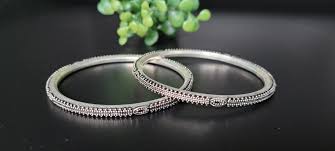All About Meenakari Jewellery

Meenakari jewellery
Meenakari jewellery making and enameling that originated in India and is still practiced today. It involves the application of vibrant colors onto metal surfaces, typically gold or silver, to create intricate and ornate designs. The word “meenakari” comes from the Sanskrit word “minakari” meaning “enamel work.”


The technique of Meenakari involves applying layers of colored enamel to a metal surface and then heating it to a high temperature to allow the enamel to fuse with the metal. This process is repeated several times to build up the desired depth and intensity of color. The enamel used in Meenakari is made from a mixture of metallic oxides, glass powder, and water. The colors used can range from bright and bold to soft and pastel and are applied using a brush or a syringe.
Meenakari jewellery is highly prized for its beauty and elegance and is often used in traditional Indian jewellery designs such as bangles, earrings, necklaces, and pendants. The intricate designs created using Meenakari can include floral patterns, paisley motifs, and images of gods and goddesses, and the jewellery is often adorned with gems and precious stones such as diamonds, rubies, and emeralds.
Meenakari jewellery has a long and rich history that dates back to the 16th century. During this time, the Mughal Empire was at its peak, and Meenakari jewellery was highly valued by the royal court. The Mughal emperors were patrons of the arts, and it was considered a symbol of wealth, power, and prestige. The art form was passed down from generation to generation, and today, it is still highly sought after by collectors and jewellery enthusiasts around the world.

The city of Jaipur in Rajasthan is considered the birthplace of Meenakari jewellery, and it remains a hub for the production of this beautiful art form. The artisans of Jaipur are known for their skills in Meenakari and are highly regarded for their attention to detail and their use of traditional techniques and designs. Many of these artisans have been trained in Meenakari by their families and have passed down their skills and knowledge from generation to generation.
The process of making Meenakari jewellery is time-consuming and requires great skill and precision. The metal surface must be perfectly smooth and free of blemishes to ensure that the enamel adheres properly. Once the enamel is applied, the jewellery must be heated to a high temperature, which can range from 800 to 1200 degrees Celsius, depending on the type of metal used. The enamel must be heated for just the right amount of time to allow it to fuse with the metal and to achieve the desired depth and intensity of color.
After the enamel has been heated, it is cooled and then polished to a high shine. The jewellery is then examined for any defects, and if necessary, the process of applying enamel and heating is repeated until the desired result is achieved. Finally, the jewellery is set with gems and precious stones, and the final product is inspected for quality and craftsmanship.


Meenakari jewellery has come a long way since its origins in the 16th century. Today, Meenakari jewellery is produced using modern techniques and materials, but the traditional methods and designs are still highly valued. Many contemporary Meenakari pieces incorporate elements of traditional Indian jewellery design, such as the use of paisley motifs and images of gods and goddesses, but they also incorporate modern elements, such as geometric shapes and clean lines.




